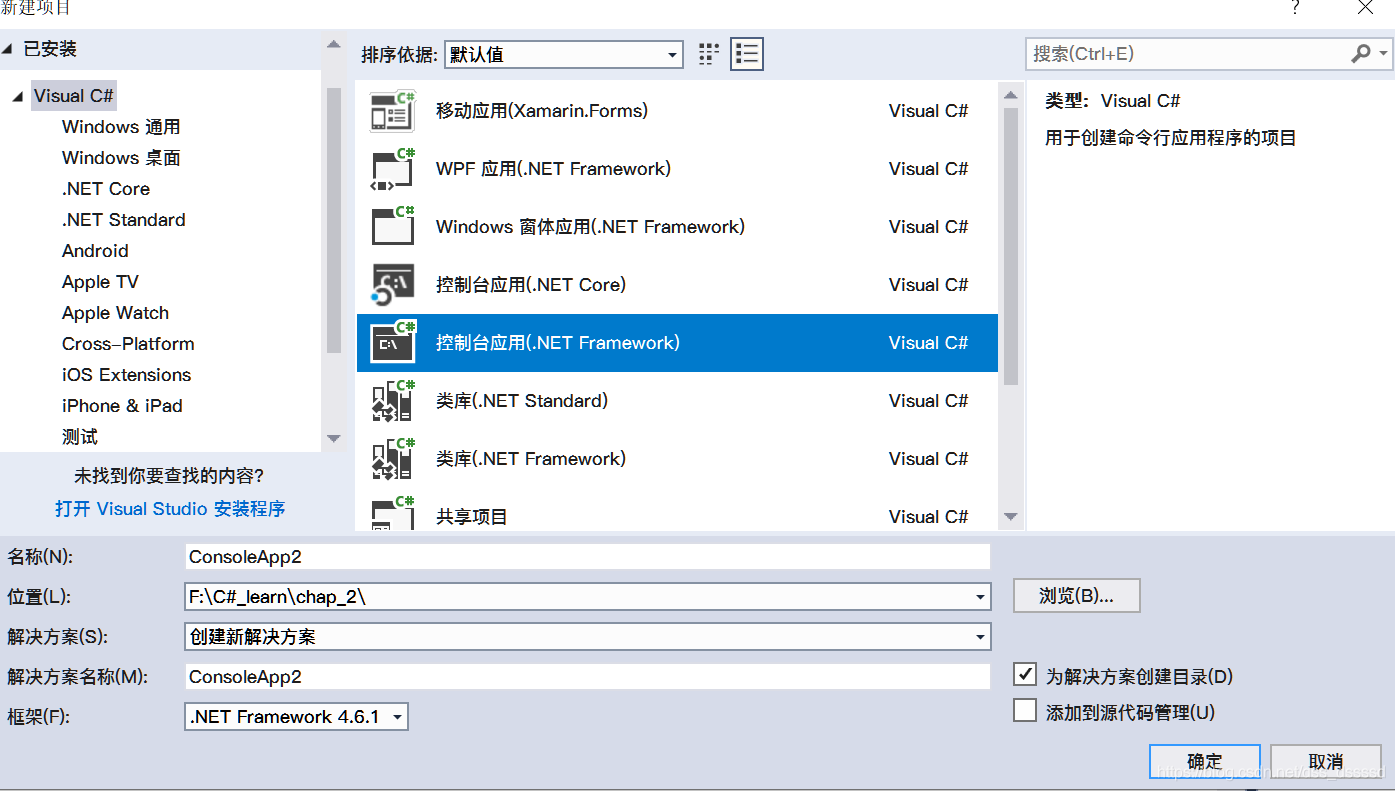一定要对比着c++学习!!!
对于第一个作业,创建C#的控制台应用即可

创建程序后:
using System;
using System.Collections.Generic;
using System.Linq;
using System.Text;
using System.Threading.Tasks;
namespace ConsoleApp1
{
class Program
{
static void Main(string[] args)
{
}
}
}
-
C# recognizes a method called Main as signaling the default entry point of execution.
main 函数作为程序执行的入口点。
-
命名空间 namespace 和 using理解 https://www.w3cschool.cn/csharp/csharp-namespace.html
以此段代码为例子讲解基本语法:
using System;
class Test
{
static void Main()
{
int x = 12 * 30;
Console.WriteLine (x);
}
}
语法(syntax)
启发于c和c++,因而比较好理解
-
indentifiers(标识符) and keywards(关键字)
-
标识符,也可以叫做变量名,是程序员为类,方法,变量起的名字,程序员可以自己定义、修改
比如: System, Test(类名), Main(函数/方法名), x(变量名), Consloe
-
关键字: 对编译器而言,有特殊含义的字母,不允许程序员自己定义、修改;程序员也不能使用关键字作为变量名标识符
比如: using, void, static, int
保留的关键字:

-
-
Literals, Punctuators, and Operators(操作符)
-
Literals:在源代码中表示值的任何记号,与标识符 (indentifiers)不同,标识符要指向内存中某一个值
https://stackoverflow.com/questions/485119/what-does-the-word-literal-mean
Examples:
"hey"(a string)false(a boolean)3.14(a real number)[1,2,3](a list of numbers)(x) => x*x(a function)/^1?$|^(11+?)\1+$/(a regexp)
-
Punctuators : {} ; ()
-
Operators: * / + - = == %
-
-
comment 注释
单行注释: //
多行注释: /**/int x = 3; // Comment about assigning 3 to x int x = 3; /* This is a comment that spans two lines */
4.Type
A type defines the blueprint for a value(
类型决定了该值拥有的方法,属性)
int x = 12 * 30
比如说, int 类型 决定了 variable(变量)x 拥有int类型的所有属性和方法。在这里可以将c#的type简单的理解为C++的class,而x是int类的对象。注意,int在C#被重写为类。相似的还有float,string等, 这是C#和C++最大的不同之处
static int FeetToInches(int feet)
{
int inches = feet * 12;
// int 类型的inches可以调用ToString方法
Console.WriteLine(inches.ToString());
return inches;
}
variable: 指向的内存地址包含的变量是可变的
const: 常量 指向的内存地址包含的变量是不可变的
这和C++的概念相同
int x = 12 * 30;
const int y = 360;
-
预定义(内建类型 built-in types)的类型: bool, string, int, float;
在C#中,内建类型为关键字(keyword),包含在System 的命名空间中, 这也就是在代码开始部分为什么使用
using namespace了 -
用户自定义类型, 其实就是C++中的自定义类
using System;
//自定义UnitConverter type
public class UnitConverter
{
int ratio; // Field
public UnitConverter (int unitRatio) {ratio = unitRatio; } // Constructor
public int Convert (int unit) {return unit * ratio; } // Method
}
class Test
{
static void Main()
{
// 用自定义的类, 创建对象
UnitConverter feetToInchesConverter = new UnitConverter (12);
UnitConverter milesToFeetConverter = new UnitConverter (5280);
Console.WriteLine (feetToInchesConverter.Convert(30)); // 360
Console.WriteLine (feetToInchesConverter.Convert(100)); // 1200
Console.WriteLine (feetToInchesConverter.Convert(
milesToFeetConverter.Convert(1))); // 63360
}
}
以后要适应type的定义。。。
- type 的成员(members):
- data members:
ratio - function members:
UnitConverter(构造函数) 和Convert
- Constructors and instantiation(构造函数和实例化)
- 对于内建类型,简单的使用 literal就可以创建一个对象了。
string myWord = 'Hello World' - 对于自定义类型, 需要使用操作符new来创建type的实例对象
UnitConverter feetToInchesConverter = new UnitConverter (12);
- 静态成员(static members)
调用对象不是实例对象(instances) ,而是类型本身。
同样的,如果只想让type本身调用某一个成员,而不想让实例对象调用,需要在成员前加static关键字
public class Panda
{
public string Name; // Instance field
public static int Population; // Static field
public Panda (string n) // Constructor
{
Name = n; // Assign the instance field
Population = Population + 1; // Increment the static Population field
}
}
using System;
class Test
{
static void Main()
{
Panda p1 = new Panda ("Pan Dee");
Panda p2 = new Panda ("Pan Dah");
Console.WriteLine (p1.Name); // Pan Dee
Console.WriteLine (p2.Name); // Pan Dah
Console.WriteLine (Panda.Population); // 2
}
}
以上代码中,如果调用p1.Population和Panda.Name,编译时都会报错
- public: 对于type的成员而言,public和c++中完全一样,实例对象可以直接调用
conversions 类型转换
C#在可兼容类型的实例对象之间是可转换的
分为隐式转换或显式转换(implicit or explicit)。和C++一样的
int x = 12345; // int is a 32-bit integer
long y = x; // Implicit conversion to 64-bit integer
short z = (short)x; // Explicit conversion to 16-bit integer
在以上两种情况都满足的情况下才能完成隐式转换:
- 编译器总是能够保证编译成功
- 在转换过程中没有信息丢失
否则,只能使用显式转换
简单的说,高精度想低精度转换,需要显式转换,因为转换过程中会有精度丢失,比如32位int类型转换为16位的short类型需要丢失掉一半的精度信息,因而需要显式转换;而低精度向高精度转换,隐式转换就可以。
其实vs 2017编译器会自动检查错误的,